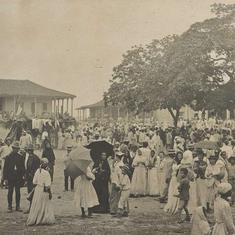With travel paralysed by the Covid-19 pandemic, technology still allows us to visit far-flung places vicariously. It isn’t just museums and galleries that have made their spaces accessible digitally. Even the very specific tirtha yatra or pilgrimage, which is intrinsically tied to physical presence, is substituted online. More Hindu temples are embracing the concept of digital darshans, allowing devotees from any corner of the world to experience the sacred act of seeing deities.
As it turns out, such impulses to travel without actually going anywhere have long been manifested in Indian visual and oral traditions. When certain sites developed as tirthas and became centres of religious and ritual practices, devotees, artists, and storytellers in distant parts of the country devised creative methods to “view” them and reap spiritual benefits.
In an ingenious inversion of the pilgrimage process, the tirtha became portable and was transported to the devotee. By way of visuals like pilgrimage maps, Shatrunjaya patas, for example, difficult to reach locations are brought into homes and local shrines. Often, these include not just the main temples or shrines but depictions of entire cities and landscapes.
Scroll paintings
While some of these images are commissioned by elite patrons and viewed by an exclusive audience, popular traditions have also brought sacred sites within the reach of devotees. As an example, art historian Jyotindra Jain has highlighted the phad tradition of Rajasthan, which combines visuals with performance to mobilise the audience-devotees.
These large scroll paintings are used by bhopa priest-performers to narrate episodes relating to the folk hero Pabuji, as well as the Dev Narayan avatar of Vishnu worshipped by the Gujar community.
Artists from the Joshi clan in Rajasthan’s Shapura, Bhilwara, Chittorgarh, and Udaipur, paint the phads, fully cognisant of the narrative that the specific bhopa patron will use it for. They incorporate real shrines like Palna ji ka Devra, Devdan ka Devra, Demali, and several others, into depictions of cities, kingdoms, alongside mythical characters who “act out” events and legends.
The bhopas, like priests of temples and shrines, use performative rituals that combine music and storytelling to transform phads into “vehicles” for the viewers to be transported, albeit through their imagination, to a sacred topography.

Similarly, the centuries-old kaavad-storytelling tradition of the Mewar and Marwar regions of Rajasthan uses portable wooden shrines made by Basayati suthars or carpenters. Unlike the phad scrolls which are displayed in their entirety, the structure of the painted kaavad allows the storytellers – kaavadiya bhats or ravs – to fold and unfold panels during with their recitation.
In her book on this tradition, Nina Sabnani compares the experience and function of the kaavad to that of a tirtha yatra, to the extent that the kaavad itself becomes a portable pilgrimage, a travelling shrine. Patrons commission storytellers to recite narratives tailored to them, which often include genealogies of their families integrated with religious stories.
But the kaavad storytellers are more than entertainers. They are the facilitators of journeys – bringing shrines to their patrons and creating purely conceptual pilgrimages with their words.
As virtual modes of pilgrimage, both traditions function much like the online darshans that are offered by many temples in India today. But they do much more by also serving as maps, or more appropriately nakshas. This distinction is important because while maps from Western cartography are diagrams that provide context of scale, measurable distance, cardinal directions and more, nakshas are a broader category comprising of visuals that are often iconised and idealised. Instead of guiding the viewers’ physical or geographical movements, phads and kaavads allow their audiences to negotiate their proximity to a shrine, tirtha or deity.
In fact, the idea of spiritual transformation is inherent in the concept of tirtha, which is defined as a crossing rather than simply a journey. Such a crossing, according to scholar Diana Eck, can be interpreted as physical movement, like travel, but also implies a transcendental passing or a change within. As the navigational needs for these metaphysical journeys varied, so did the iconographical and visual tropes that communities of artists and performers came to rely on. Moreover, it is very likely that at the time at which these traditions became popular, most audiences had no other way of viewing the sites and shrines.

The current proliferation of print images and digital resources makes it possible for viewers to be familiar with iconic sites, landmarks, and monuments without ever having visited them. But has access really changed all that much? Though it is true that hazardous yatras, like those to Kedarnath and Amarnath, have become somewhat easier with newer means of travel, changes in technology have not guaranteed access for all.
As Sabnani points out, the hierarchies of caste, religion, and feudal structures still restrict sections of Indian society from entering many sacred spaces. In most cases, it is only through painted kaavad shrines that these patrons can situate themselves in the presence of the deity. Though such inequalities gave rise to alternatives to pilgrimages, the resulting traditions are not always equitable. Misguided notions of impurity that have long been associated with women control how close female devotees can be to these objects. Specifically, they are not allowed to touch consecrated phads because they are believed to be Dev Narayan shrines not just representations.
As we consider these issues, it is but natural to draw parallels with current restrictions in movement caused by the pandemic. Now, more than ever, privileges of access to safe spaces and lifesaving resources have revealed disparities in societies all over the world. Faced with tragedy, many of us have sought comfort in the arts. Like the viewers of phads and kaavads, we have remotely accessed places that we can no longer enter physically.
Day after day, we have entertained ourselves with stories and embarked on mental journeys as prolonged periods of isolation and uncertainty push us to cross over and emerge, collectively, transformed.
Vrinda Agrawal is a PhD student in the History of Art at the University of Michigan.










